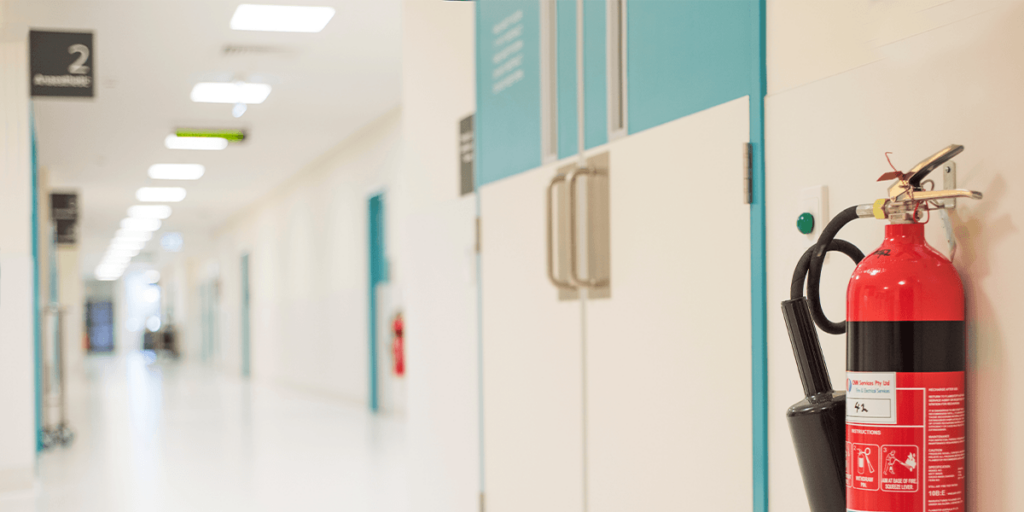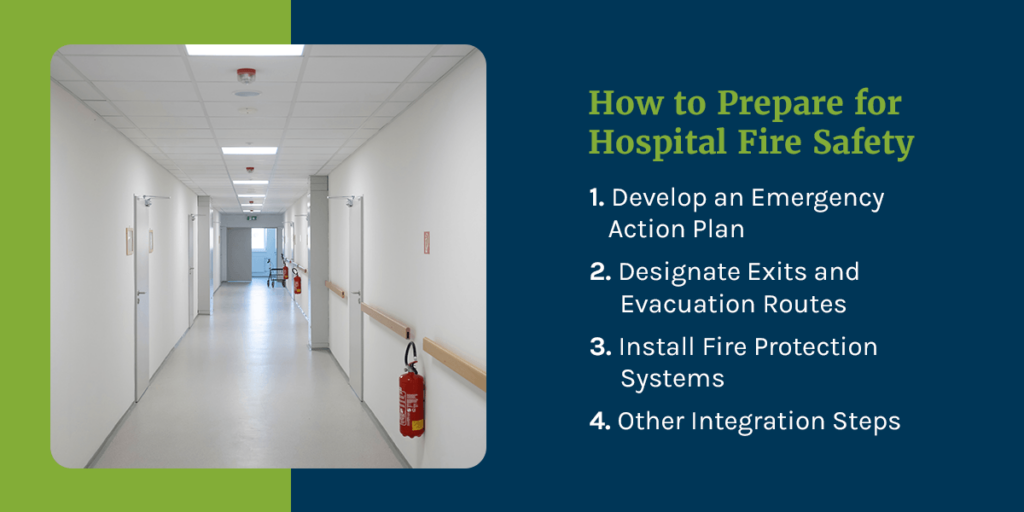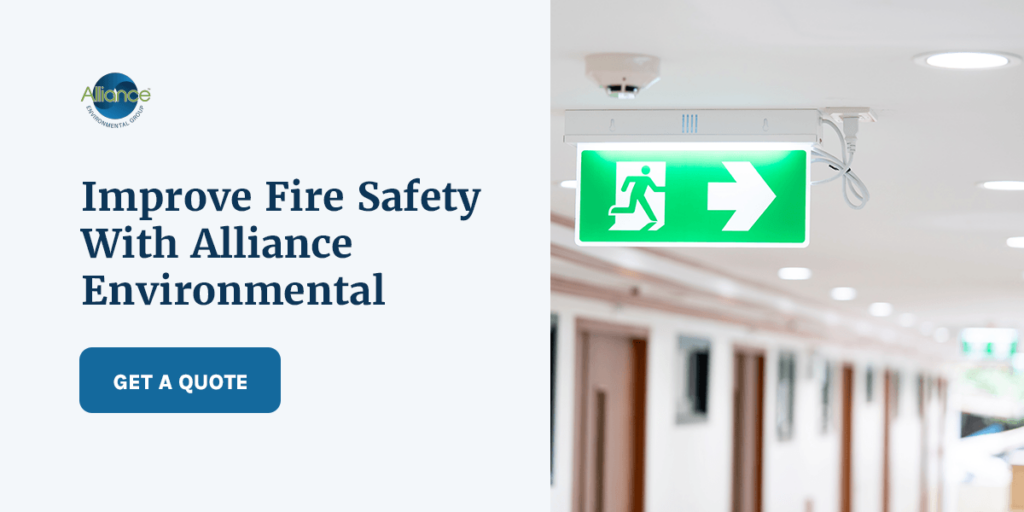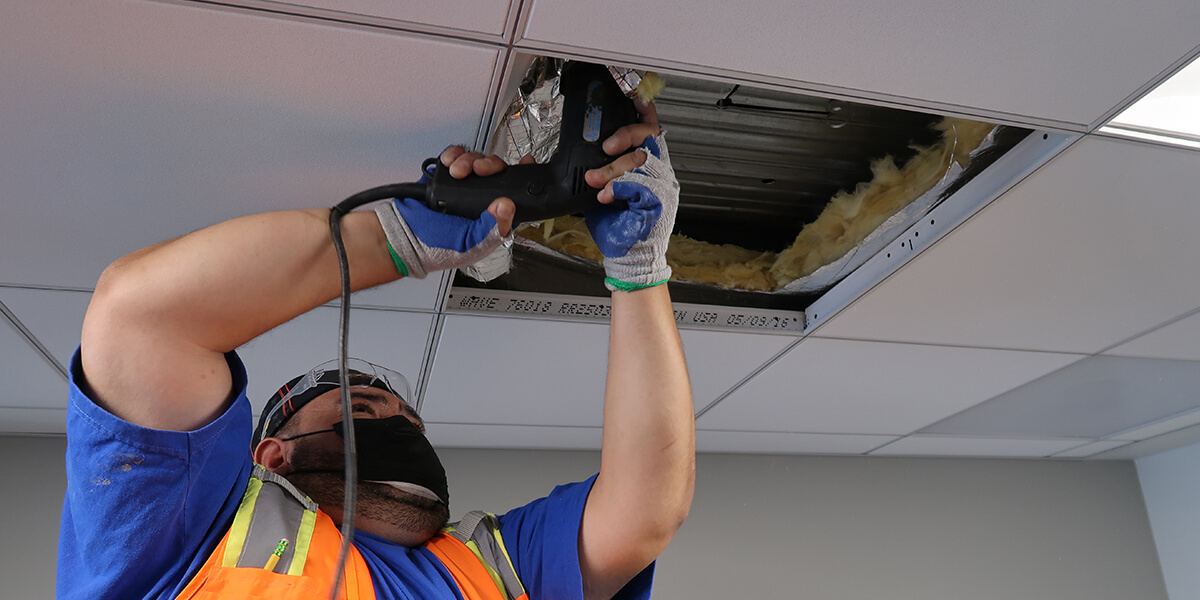
Fires have disastrous impacts on hospitals and other healthcare facilities. Fires threaten patient lives and can cause severe damage to infrastructure and treatment equipment.
Thorough fire life safety plans can reduce fire risk and increase safety. Learn more about emergency preparedness for hospitals and how Alliance Environmental can help.
Hospital Fire Hazards
Staying aware of potential hazards increases your facility’s safety. No matter their structural design, hospital fires can occur for various reasons:
- Heated equipment: Hospitals use a wide range of equipment to treat patients and manage administrative needs. Many of these components use heat to function or become hot during use, such as defibrillators. For instance, monitors can overheat when faced with too many tasks at once. In severe cases, the equipment can catch fire and spread to other hospital areas if not contained.
- Faulty electrical wiring: Electrical fires cause an average of $1.5 billion in property damages each year, making them significant threats to infrastructure and safety. Most hospitals rely on electricity to power equipment, lights and other essential components. Various wires, lights, cords and power supplies pose risks of catching fire. These features can malfunction, emitting sparks and causing fires. Wiring can also wear down over time, losing its ability to contain electricity. It’s crucial to monitor electric systems and update them when needed.
- Flammable chemicals and materials: Hospitals also store various flammable chemicals and materials that can become fire hazards if placed in unsafe conditions. They need to stay at the proper temperature and storage conditions for optimal safety.
- Kitchen facilities: Cooking is the leading cause of internal fires. Most hospitals have kitchen facilities to serve patients meals during their stays. Fires can start from excessive temperatures, unattended equipment, nearby materials contacting the stove or other conditions.
How to Prepare for Hospital Fire Life Safety
Hospital emergency preparedness is crucial for patient and employee safety. All hospitals must have plans in place to address fire safety. The Occupational Safety and Health Administration (OSHA) has significant requirements for hospitals to follow to mitigate fire hazards. Hospitals need to prepare facilities for potential fires by following all OSHA standards.

Here are four steps to follow for hospital fire life safety:
1. Develop an Emergency Action Plan
According to OSHA guidelines, all hospitals must maintain an emergency action plan in case a fire occurs. Hospitals must draft these documents in writing and keep them available for employees to review at all times.
Emergency plans must include these elements:
- Designated exit routes: Your emergency plan must outline all designated evacuation routes for every hospital area. Employees and patients should move toward their designated exit immediately.
- Evacuation plans for all individuals: In addition, the emergency plan should detail specific evacuation plans for patients and employees. For instance, certain employees become responsible for transporting patients with disabilities to their specific exit routes. Other workers are responsible for staying behind and powering off devices. If needed, a certain percentage of hospital workers must be able to perform medical or rescue duties once all patients have been evacuated. The document should provide exact details of employee responsibilities and patient monitoring procedures.
- Alert system details: OSHA also mandates the use of an employee alarm system that signals when a fire breaks out. The emergency plan should explain the alarm’s appearance and sound quality so that employees can immediately recognize it.
2. Designate Exits and Evacuation Routes
OSHA has additional requirements for hospital evacuation routes. Each hospital should meet these requirements for exit routes:
- Maintain a sufficient amount: According to OSHA, all hospitals must have a minimum of two exit routes for fires. Depending on the hospital’s size and number of employees, the facility might need more to maintain an adequate safety level. Hospitals can reference the OSHA regulation to find the closest recommendation for their facility’s needs.
- Design doors that lead directly outside: All evacuation routes must lead directly outdoors. The route might lead to a street, walkway or public space. The outside area should have enough space to hold all patients and employees safely and comfortably.
- Construct doors to necessary height and width requirements: OSHA also lists specific dimensions for height and width that the hospitals should follow during construction. For instance, an exit route ceiling must be at least 7 feet and 6 inches high.
- Add proper labels and lighting: Your emergency exits should all contain proper signage and lighting that clearly signal their presence. Employees and patients should be able to identify the doors easily, even in dim lighting.
- Remain unlocked and accessible: Evacuation routes and emergency exits should stay unlocked and available for use at all times to increase safety.
3. Install Fire Protection Systems
In addition to drafting an emergency plan and preparing exit routes, OSHA requires the installation of fire protection systems throughout hospitals. Some of the protection systems include:
- Fire doors: Installing fire doors and ensuring they are functioning correctly is a simple way to prepare your hospital for a fire event. They can effectively limit the flames and smoke from spreading throughout a facility to minimize damage and give the personnel inside more time to evacuate safely.
- Fire dampers: Every hospital should have fire dampers within the building’s HVAC system. These solutions create a barrier that halts the spread of smoke and fire throughout the facility’s air ducts and ventilation network.
- Fire-stopping and cable management solutions: Hospitals can further protect their facilities by installing fire-stopping materials around pipework, cables and electrical conduits to slow the spread of smoke and flames. These solutions allow your team to utilize essential equipment during a fire emergency.
- Standpipe systems and hoses: Standpipe systems allow firefighters to deploy hose lines quickly once they arrive at the fire. The systems can reach varying pressures and volumes, helping emergency responders assist with fires of varying intensities.
- Automatic sprinklers: These devices switch on automatically after detecting smoke or fire, helping to mitigate some of the flames. Regularly have a professional clean your hospital’s fire sprinkle heads to ensure they are effective when needed.
- Fire detection systems: These systems are installed throughout buildings and are designed to detect and alert inhabitants of fires. Smoke and heat detectors can identify fire presence and send out alerts to all building users.
- Employee alarm systems: Other alarm systems emit a specific sound to signal the fire presence to all employees. Workers receive training to understand and act according to the specific signal sound.
4. Other Integration Steps
In addition to implementing OSHA standards, hospitals can also reduce fire risk with other steps, including:
- Training: Hospital management should conduct thorough fire safety training with all employees. The training should include a thorough explanation of emergency action plans, including an explanation of specific worker expectations. Other practices like fire drills help workers practice evacuation routes and procedures, preparing them further for emergencies.
- Monitor cords and wires: In addition, hospitals should keep close monitoring on all electrical appliances and wires in their facility. Outdated wires have an increased fire risk. Regular monitoring and replacements help you minimize electrical fire risk.
- Keep fire systems updated: You should also have an expert regularly inspect and test fire systems, ensuring they’re up to date. If systems run out of batteries or become damaged, they can’t alert employees and patients properly. Consistent inspections help you make sure the systems are in the best condition.
Improve Fire Life Safety With Alliance Environmental
Fire safety procedures are essential for patient and employee safety. If you want to advance your fire protection measures, choose Alliance Environmental today. Our comprehensive fire safety services meet the stringent requirements of the National Fire Protection Association and OSHA. Our inspections, replacements and safeguard procedures increase your hospital’s protection against fires.
To get started with Alliance Environmental, request a quote today.




